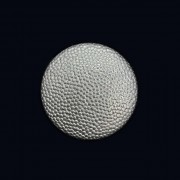Description
Original German three-hole buttons "plates" made of non-ferrous metal. Diameter 17-18 mm. The buttons are only washed (not cleaned mechanically). The condition can be seen in the photo: the surface may not be completely smooth, but there are no holes or rotten edges. A little care (with the help of a skin) will dramatically improve the appearance. Buttons made of non-ferrous metal do not deteriorate from washing, but on the contrary get cleaned!
We offer zinc and aluminum, choose the material before ordering. If you find no metal you want there, then it is sold out.
Zinc ones are less common. Aluminum usually looks better. If you have high requirements, then take a little more buttons than you need to choose yourself.
Historical reference.
Buttons with three openings were used in the XXth centruty on German equipment (bags/Brotbeutel, tents/Zeltbahn, backpacks/Rücksack) and very rarely (at the end of the war for economic reasons) to complete the clothes. Three holes provide striking sustainability of buttons against tearing even when on dry or putrescent yarn. Such buttons may be found on battlefields with a torn bridge between the holes: i. e. button physically broke, and not come off.
The buttons were made of aluminium, zinc and steel. Very rare they might be bakelite (material based on resin and fillers), brown colour. Zinc buttons - the earliest, pre-war. Aluminum were produced before the war and up to 1940, then steel buttons began. Most often these were made of a very thin sheet of steel (about 0.3 mm), which was covered with a gray semi-matt paint (without galvanizing). The paint on the original buttons could cleave, and they rusted. We don't need saving, we do the steel buttons of 0.7 mm steel coat them with zinc for corrosion protection. For full compliance, you can cover them with gray paint by yourself.
























